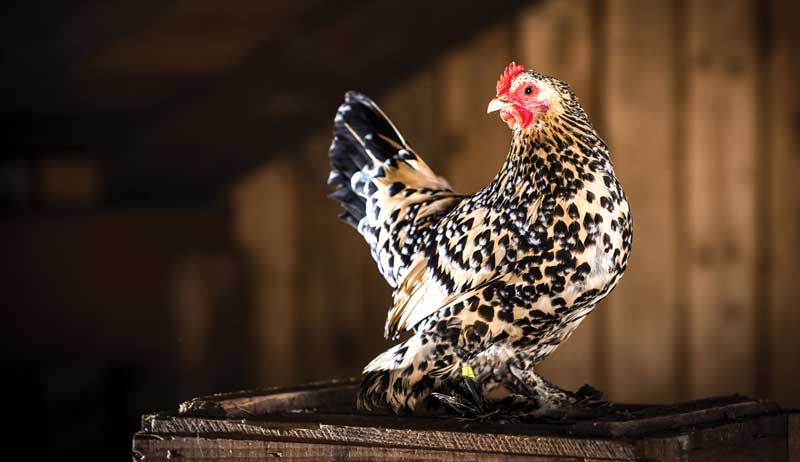Bantam chickens can make a wonderful small flock. Keeping three or four bantam hens increases self-sufficiency for anyone engaged in small-time poultry-keeping. Bantam hens, notorious for setting and brooding, make excellent surrogate mothers for many species of domestic poultry, including chickens, ducks, pheasants and turkeys.
They make perfect birds for those living on the grid, as well as anyone wanting to live off the grid. They are nature’s perfect incubator, egg turner and chick brooder, all built into one convenient, dependable unit. Best of all, they require no utilities or power to operate. They are one of the most convenient and trouble-free ways for a homesteader to increase their small production or laying flocks. Fertile eggs, from the best-producing birds in another flock, can be set under bantam broodies as a low-cost and highly successful way to increase the flock.
These little marvels of nature make capable, ideal mothers and can be used to hatch and incubate eggs from other types of poultry. They even take care of the babies after they hatch. Bantam hens are notorious for going broody, sometimes two or three times in a year.
Choose almost any well-known breed of standard-sized chicken and chances are you’ll find a bantam version that has been developed as its counterpart. Bantam hens are small, usually less than half the size of their full-sized cousins. As miniature versions of much bigger fowl, you can keep them in a smaller coop or run.
Because they have often been raised as pets, many bantams maintain a generational predisposition for friendliness and curiosity around humans. As such, they’re generally easy to maintain.
Because of their much smaller size, feed consumption is also much lower than with standard-size fowl. Some breeds, such as Silkies or Cochin bantams, are well-known for wanting to set on eggs and hatch out a family. Other breeds—Old English Game, Japanese and Belgian bantams—often exhibit high tendencies for broodiness and excellent mothering skills as well.
To give an idea of the difference between standard-sized chicken breeds and bantams, look no further than the example found in Cochins. According to the American Poultry Association’s Standard of Perfection, fully mature, standard-size Cochin hens should weigh 8 1⁄2 pounds when fully mature, and a rooster should weigh 11 pounds. On the flip side, a Cochin bantam hen should weigh 26 ounces and a rooster should weigh 30 ounces. Some breeds will be a few ounces heavier or lighter. Even so, most bantam hens can successfully incubate four to six larger eggs while setting.
Besides being curious, personable pets and wonderful mothers, many bantam chickens make decent little layers. While maybe not the egg producers that a Leghorn or Australorp might be, many breeds of bantams will lay three or more eggs per week during the spring and summer months. Some birds will even keep laying into the winter (but in most cases, this is an exception and not the rule.)

Hens & Roosters
Most breeds, once they start laying, will lay small eggs with high interior quality and strong shells. These eggs are wonderful for home use or selling. Even with their small size, many customers find these eggs to be of desirable quality and will buy them on a repeat basis, if you have them available.
Bantam roosters are often known for their endearing and often inflated egos and attitudes. What they lack in size, they make up for in personality. Bantam roosters will try to defend their perceived territory against much larger males, without hesitation. They love to crow and strut around, letting the world know that they’re in charge. If you keep a bantam rooster with your hens, you can raise a few new “banties” every year and increase your brooder flock as well.
Bantam chickens tend to be clutch layers, meaning that they lay a clutch of eggs, often 18 to 20, and then go into a broody state and set on the clutch to incubate and hatch the eggs. If a person keeps the eggs gathered and removed daily, this will slow the tendency to set but not for long.
After laying her eggs, usually over a six- or seven-week period, nature will take over and the bantam hen will go broody. She’ll flatten herself as far as she can and spread her little body out as she sits in the nest, assuming a position to allow her to cover as many eggs as possible and keep them warm. This flattened position also makes her less visible to predators if in the wild—nature’s way of making sure she and her babies are safe.
She will lay claim to any eggs laid in the same nest by other hens and quickly roll them beneath her, with her beak. Once broody, the bantam leave the nest for only a very few times each day to eat and drink and then return to her duties of keeping the eggs warm. She may become very protective, make soft gurgling warnings or squawks, and peck any individual who should have the audacity to stick their hand into her nest to try to steal her eggs.
Despite all the theories and folk wisdom about breaking a broody hen from her desire to set, it can be nearly impossible to deter a bantam hen from going through the complete brooding and setting cycle, even if all eggs are removed daily. The process is hardwired into their brains at a cellular and molecular level. If you are keeping these hens as broodies or surrogates to hatch and raise the eggs of your other poultry breeds, this is exactly what you want and need.
One of the most interesting phenomena of broodiness is how infectious it is in a flock. It doesn’t take long after one bantam hen starts brooding and setting before another hen also becomes broody and joins her, often in the same nest box. This makes for a very good situation when the hens are being kept for the purpose of brooding new stock, as this means more eggs can be set and hatched.
Once the eggs hatch, rarely any squabbling or fighting over the babies occurs. The two hens will work together and use their natural mothering tendencies to nurture and raise the babies as a team.

Why Use Bantams Chickens?
Some breeds of larger fowl also have tendencies toward broodiness. Standard Cochins are one of the most reliable. A larger hen is also able to incubate a larger number of eggs than a bantam. However, for reliability and repeat broodiness, bantam breeds such as Silkies, Cochins, Old English Game and Japanese are hard to beat.
From the 1920s into the mid-1950s, government-funded poultry-improvement programs recommended that poultry farmers cull hens with a tendency to go broody and set, to increase egg production. A broody hen doesn’t lay eggs once she fully enters her brooding cycle. Consequently, such hens were often removed and met their fate in the stew pot.
Over the decades, the genetically inherited trait of broodiness was bred out of many standard breeds. Because bantams have traditionally been kept as pets instead of for commercial production, many breeds of bantams never lost this valuable trait.
Small Housing
Bantams don’t require much room. A small flock of three to six bantams can live very comfortably in a coop with floor dimensions no bigger than 4-by-4 feet, and a pen or yard no bigger than 4-by-8 feet in size.
Waterers and feeders should be of a design that the babies can have easy access but not fall into water too deep for them and drown. One or two nest boxes just above floor level are ideal. Placement near the floor will ensure that baby chicks can get back in under mama hen to keep warm.
Make sure the nest box is wide enough for two hens to spread out comfortably. In hot weather, excess body-heat buildup from two hens sharing a very small nest box can cause heat stroke in one or both hens.
If you are keeping a small flock of bantam chickens for raising baby chicks, wire mesh securely fastened around and over the run is best. You don’t want a situation where small chicks can escape through larger holes in chicken wire and be lost to the elements or predators.
Make sure that your pen is very sturdy and the wire is securely attached so marauding neighbor dogs or wild animals such as raccoons can’t break in. Small holes no bigger than the diameter of a quarter will allow rats and weasels to enter. Both can and will kill baby chicks, as well as adult bantams. Before building the coop and run, pour a slab of concrete 3 to 4 inches deep to prevent these animals from burrowing in through the soil.
Keeping bantam chickens can be a great addition to any backyard. They require less space and feed than large fowl breeds and are known for their friendly personalities. Bantam hens are notorious for going broody, too, which means they make excellent surrogate mothers for other types of poultry. They’re nature’s perfect incubators, egg turners and chick brooders.
Overall, keeping bantam chickens can be a fun and rewarding experience for anyone interested in small-scale poultry-keeping.
Best Broody Bantam Chickens
Most bantam breeds will exhibit broodiness at some point. However, a few breeds are almost sure bets for going broody. Some hens may not exhibit this desire until their second laying season. This is common. As hens become older, their setting and brooding desires tend to become stronger. Older hens often make the best mothers. Here are a few breeds to consider.
Silkie
These fluffy little chickens, with their soft downy feathering and loving, calm dispositions, come in several colors, including white, black, blue, gray, paint (mottled or speckled) and others. The quintessential example of a broody hen, they’re probably the most reliable setters. They make wonderful mothers, have calm dispositions and are perfect for families with small children.
Cochin
The bantam version of this breed is every bit as reliable for purposes of brooding and setting as Silkies. They have calm dispositions and are inveterate setters and brooders. They are a sure bet for use as surrogate mothers for other fowl. These little fluff balls, with their feather shanks and thick feather coats, come in several colors, are calm and gentle, and are also perfect for families with children.
Old English Game
These small, alert little birds, with standard feathering and noticeably larger tails and drooping wings, come in several colors and patterns and are a showy bird that you will be proud to own. Not quite as docile as a Silkie or Cochin, they are very dependable setters and make excellent mothers. Because they can be a bit flighty and roosters a bit aggressive at times, they may not be suitable for young children.
Japanese
With large tails, shorter shanks and wings that also appear to droop, these birds make excellent mothers, and the hens get along well with other breeds. They come in several colors and are beautiful conversation pieces that you will be proud to show to your friends.
Belgian d’Uccle
Besides being living showpieces, this personable, gentle, feather-legged breed makes for wonderful setters and mothers. Be aware that many owners of the birds say they tend to not go broody until their second laying year.
This article about bantam chickens originally appeared in the September/October 2023 issue of Chickens magazine. Click here to subscribe.





















